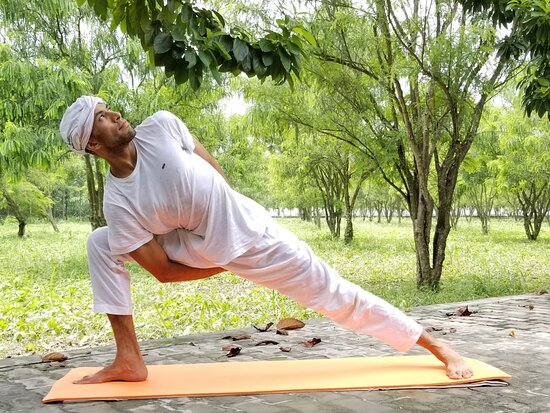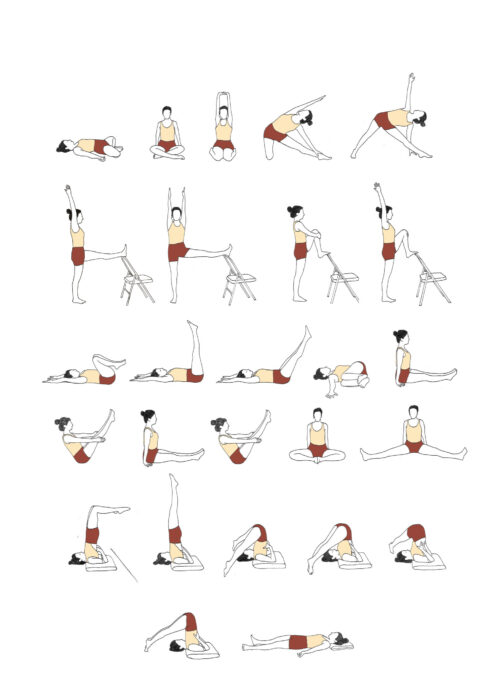
The first few poses of waking up yoga are designed to open the chest, shoulders and hips, but they also need to be done with an open mind. Begin by looking up into the sky. You should only allow your head to move back as far as you are comfortable. These postures are not meant to warm the spine or whole body. They are intended to relax the muscles and joints. Keep going for seven to ten rounds. You should be relaxed and aware of how you move. You should be capable of practicing the postures with either your eyes closed or open.
Tadasana / Mountain Pose
Tadasana is also known as Mountain Pose. It's a classic asana that works to get the body moving and improve posture. To perform this pose, you will need to use many muscles, including your flexor and extensor. This position can be great for self-esteem improvement and balance. Here are some tips to help beginners.
Do not be afraid to try this asana. It is a solid foundational position for your body. This pose is a great place to practice breathing and an excellent way to increase confidence. Mountain Pose also requires one to do yoga from the ground up and work on alignment. This yogic posture can help you wake up and feel more confident during the day.
Pay attention to tension areas
Before you begin your yoga practice. Are you feeling tension in your chest or inner arm? These areas are likely places of tension. These tensions will disappear as you practice yoga. You will notice tension in your body when you do yoga. This is a sign that you are becoming more aware of yourself. Observe where you experience tension and breath into those areas.
Yin yoga

Yin yoga for waking up is great for maximizing the benefits of cold muscles. It aids in waking up quicker, increases flexibility, and removes tension from deeper connective tissues. Mornings can be stiff, and tense. Yin yoga is perfect to release tension from these layers. It promotes body awareness. It is a great way to wake up your body, and it can also help you reduce stress and manage pain.
Yin Yoga has been proven to reduce anxiety and stress levels. It relaxes the body through the use the parasympathetic neural system. This calms the body and prevents it reacting to stress with the fight-or flee response. It is also beneficial for people who have low energy or feel their bodies losing their flexibility with age.
Prayer Pose
To get your morning started on the right track, you can try the Prayer Pose. This yoga pose will help you to get off to a great start by relaxing your body and giving you a calm mind. To do this pose, keep your shoulders straight and spread your fingers outward. Press your fingers into your back while in this pose. You can hold for up to 15 deep breaths. Now, focus on blending the movement of breath and movement.
You can also hold the reverse Prayer Pose to strengthen your arms and shoulders. The shoulders move in a manner that opens the chest, promotes digestive function, and increases metabolism and energy levels. The Yoga pose reverse version is a good option for those with wrist pain. Acupuncture points are located in the wrists of people who spend hours typing on a computer. This will make you feel more relaxed all around.
Plank pose
Plank is an essential element in waking up yoga practitioners. There are many benefits to this dynamic pose. This pose engages the arms, legs, and is especially good for the heart as well as the core. It can be held for five breaths, and you can also choose to hold the pose with your knees on the mat. Several variations of the Plank pose are also available, allowing you to extend your leg perpendicular to the floor and strap the foot to the mat.

Start by straightening your spine, and then engage your thighs. Your shoulders should be in line with your ears and your tailbone should point towards your feet. As you hold the pose, your eyes should be looking forward. Focus on your breath and not your back. Try to maintain neutral posture throughout the entire practice. If you have any injuries or health conditions, it's best to consult a physician before practicing yoga.
Keep an eye on your breath
Being aware of your breath is an important part of yoga. This practice will allow you to benefit greatly from it. You need to be aware of your breathing in every situation. Start by simply noticing your breath every time you walk, sit or lay down. Focus on your belly, chest, and stomach as you breathe. Practicing this exercise in private will allow you to gain a deeper understanding of your breathing.
Mindful attention is key to becoming a scientist of the breathe. It has been shown to help people manage their emotions and increase connectivity in the amygdala and prefrontal cortex. This results in greater calm and lower anxiety. This technique may improve your sleep quality and help you be more alert. You can start with as little as five minutes of breath observation, and gradually increase the time you spend on it.
FAQ
Which 5 ways can we improve our wellbeing?
Wellbeing is defined as "the state of physical, mental, spiritual, and social well-being". Several factors affect our well-being, such as family, work, health, relationships, community, environment, education, finances, etc. Your first step to bettering your well-being, is to identify the areas in your life that require improvement. Next, change these things to improve your well-being.
Here are five methods to improve your health and well-being.
-
Exercise - Exercising makes you happier.
-
Sleep – A longer sleep time reduces stress and anxiety.
-
Nutrition - Eating healthy foods (such as fruits and vegetables) will boost your mood.
-
Meditation - Regular meditation can reduce stress and anxiety.
-
Socialization – Spending time with family and friends makes us feel happy.
What can I do if I have mental health problems?
It is vital to seek support if you are experiencing any mental health problems. There are chances that you have suffered trauma or abuse in your past. This could have affected your perception of yourself.
You might also have an eating disorder, addiction or other type of mental illness. These disorders can cause significant damage to your personal and professional life.
You shouldn't try to deal with them on your own. Talk to someone who is familiar with the subject. You can get the support you need from a professional therapist to help you overcome these difficulties.
How does mental well-being affect daily life?
Everybody experiences mental illness at some time in their lives. The difference between individuals with mental illness or others is the fact they don’t seek treatment. Talk to someone when you feel that something isn't right. There are many ways to deal with depression, anxiety, stress, etc., such as therapy, medication, exercise, diet, meditation, and other methods.
Statistics
- More than 50% will be diagnosed with a mental illness or disorder at some point in their lifetime.3 (cdc.gov)
- Similarly, for positive mental health, there is likely to be substantial agreement about some typical components (e.g., resilience to stress) 6, and controversy about more atypical components (e.g., career consolidation). (ncbi.nlm.nih.gov)
- It does have some influence, but not nearly as much as we might think, so focusing less on attaining wealth will likely make you happier (Aknin, Norton, & Dunn, 2009); (positivepsychology.com)
- More than 40 million adults in the United States have an anxiety disorder, but less than 37% of people seek mental health treatment for their symptoms. (talkspace.com)
- It means no drinking any alcoholic beverages and no taking any drugs that aren't 100% natural.
External Links
How To
How to Manage Stress
Stress is a normal part of life; however, when we feel stressed, we want to find ways to relax and relieve our tension. Stress can have a negative impact on every part of your life. Stress can lead to physical problems like headaches, neck pain and back pain, as well as stomach aches, constipation. You may even develop ulcers if you're under chronic stress.
There are many things you can do to reduce stress. Exercise can help you release endorphins which makes you feel happy, relaxed, calm, and peaceful. Meditation helps reduce stress by slowing down, and taking deep breathes. Yoga is another great way to help reduce stress and improve overall health.
Stress management is best done by learning how to control it and then eliminating it entirely. Ask someone who knows what to do if you are unsure.